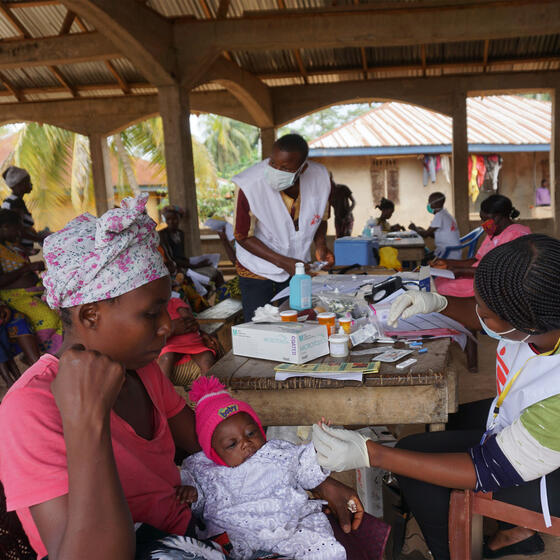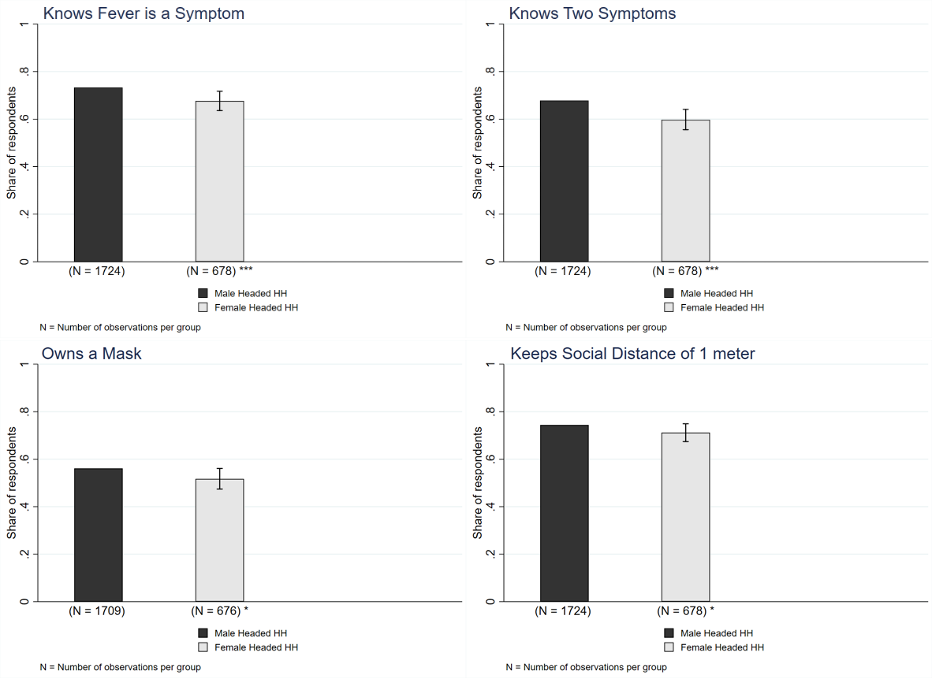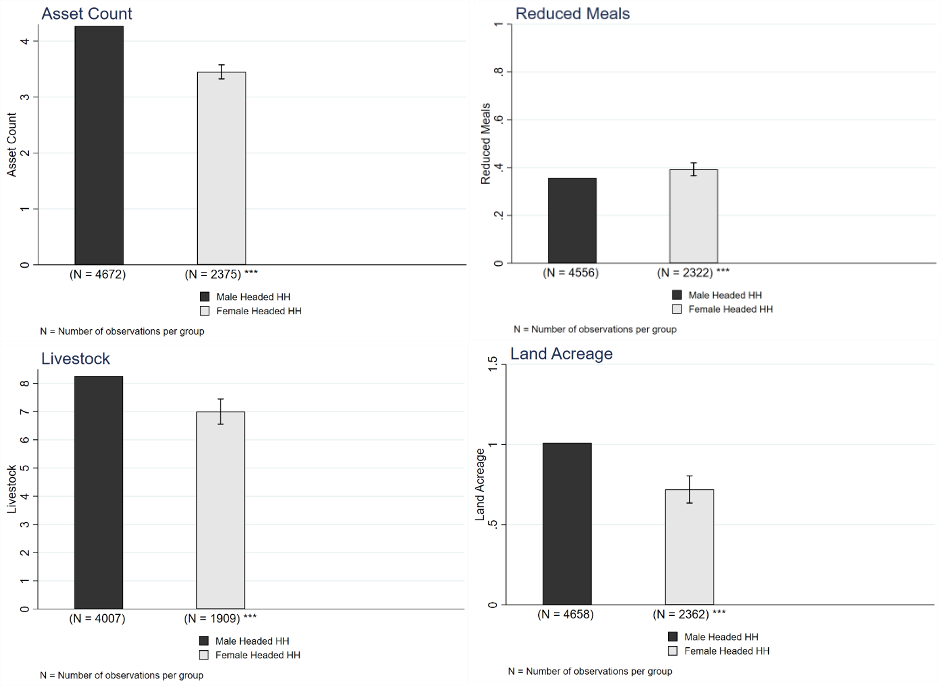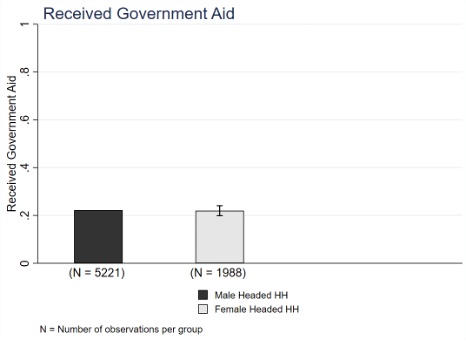How COVID-19 Is Making Gender Inequality Worse in Low-Income Countries—and What to Do About It
Gender disparities in social and economic outcomes, already larger in the developing world than in rich countries, have been exacerbated by the pandemic, according to Yale SOM’s Mushfiq Mobarak and his co-authors. They write that policy action is badly needed to address the compounding of existing inequalities and protect the most vulnerable women.

A Doctors Without Borders healthcare provider with a mother and her child at a mobile clinic in Sierra Leone in July 2020. Photo: Saidu Bah/AFP via Getty Images.
COVID-19 has exacerbated the existing inequalities between men and women in terms of economic, health, and educational outcomes. Examples of the disproportionately negative effects of the crisis on women are seen around the world (Alon et al, 2020; Adams-Prassl et al, 2020). But women in low- and middle-income countries have faced specific, additional challenges.
For example, in Sierra Leone, families where the male head of household is absent due to divorce, death, or long-distance migration were more vulnerable even before the pandemic. Early on in the crisis, households headed by women were less likely to be well informed about the disease, as a result of weaker access to sources of information and social networks. During the crisis, they have elevated rates of food insecurity compared with male-headed households, with the gender differences even starker among the poorest families.
Policies in response to the pandemic need to take account of such gender disparities both to prevent the compounding of existing inequalities and to protect the women who are most vulnerable.
The experience of women in low- and middle-income countries
Globally, 40% of employed women work in services and labor-intensive segments of manufacturing, such as garment production. These sectors have been among the most adversely affected by the pandemic.
Women also constitute a majority of healthcare, social, and domestic workers, jobs characterized by limited protections, but also greater risk of infection (International Labour Organization, ILO, 2020). They are also more likely than men to reduce their paid working hours or leave their jobs due to the increasing burdens of unpaid work—caring for children and the elderly.
Such gender disparities are likely to be exacerbated in low and middle-income countries, where gender gaps in social and economic outcomes are greater (Jayachandran, 2015). In these countries, the gendered nature of work is typically accompanied by less progressive attitudes towards women working in the labour force (Jayachandran, 2015). In addition, a large share of women in developing countries are self-employed, and they may have to divert family money and resources away from their own micro-enterprises during times of crisis.
Many women in low- and middle-income countries perform most of the household chores and provide care for children. In South Asia, the Middle East, and North Africa, the share of women in unpaid work is as high as 80–90% (McKinsey, 2020). School closures and mobility restrictions during the pandemic have further increased the burden of domestic work and constrained the hours available for compensated work.
There are limited data available on how the COVID-19 crisis is specifically affecting women. A UN Women Report expects the pandemic to deepen gender poverty gaps, especially in already-impoverished regions such as sub-Saharan Africa and South Asia. To make up for the lack of data on vulnerable populations in low- and middle-income countries, researchers are using phone surveys to collect data over time for representative samples (see examples from Bangladesh, Nepal, Kenya, and Sierra Leone).
In addition to experiencing economic consequences, women are at increased health risks. The pandemic restricts women’s access to maternal healthcare, as resources are reallocated to COVID-19 patients. This was also the case during the Ebola outbreak of 2014–16, when the increased burden on the healthcare system reduced access to family planning and maternal health services, thus increasing the chances of maternal mortality. Women’s role as caregivers at home and in health clinics also makes them more vulnerable to infection (Menendez et al, 2015).
Girls’ access to education can also be affected by such crises. A study investigating the impact of school closures as a result of the Ebola crisis in Sierra Leone found younger girls staying out of school more (Bandiera et al, 2018). They also found it harder to re-enroll after schools re-opened, instead taking up work. Adolescent girls ended up spending more time with men, resulting in higher likelihood of pregnancies, especially out of wedlock. The disruptions to the healthcare system due to the Ebola crisis increased the dangers to these young women.
Lockdown and quarantine measures make women more likely to be victims of domestic violence (Taub, 2020; Peterman et al, 2020). One study finds that the increased economic dependence of women and reduced access to external support is causing the surge in domestic violence in many countries during the pandemic (Mittal and Singh, 2020). The Kenya COVID Tracker records self-reported data on the incidence of gender-based violence during COVID-19. While threats of violence and fights between household members increased initially during the lockdown, actual violence by partners did not.
Early on in the pandemic, households headed by women were more likely to have skipped a meal than male-headed households, according to high-frequency phone survey data from Kenya. As examined in more detail below, this was also the case in Sierra Leone.
The experience of households headed by women in Sierra Leone
Sierra Leone represents a unique case to assess the gendered impacts of COVID-19. Around one-third of households are headed by women—these are families where the male household head is absent due, for example, to divorce, death or long-distance migration. It ranks very low on the gender inequality index (which means it has high levels of inequality) and records high rates of maternal mortality and violence against women. During the Ebola crisis, an overwhelmed healthcare system affected pregnant women acutely, resulting in many maternal deaths.
Research using data from a large sample of representative households in Sierra Leone finds that households headed by women were more vulnerable than their male-headed equivalents even before the COVID-19 crisis hit.
First, as a result of accessing different sources of information and engaging with different social networks, households headed by women were less well informed about the disease early on in the crisis. On average, they are less likely to know about common COVID-19 symptoms such as coughing, fever, difficulty breathing, and loss of smell. They are also less able to adhere to public health guidelines, such as mask wearing, because they are less likely to own a mask, and are less likely to keep social distance (see Figure 1).
Figure 1: Differences between households headed by men and women on public health measures

These differences may arise because women and men use and trust different sources of information. Women in Sierra Leone tend to rely less on information from the state (elected officials and the Ministry of Health) and more on family and friends. The fact that their social networks are predominantly family members reflects this. Crucially, these findings can inform future awareness campaigns and how they should be designed to target women’s social networks.
Second, households headed by women in Sierra Leone have elevated rates of food insecurity compared to male-headed households. The differences here are starkest among the poorest families.
Households headed by women own smaller land holdings, and fewer assets and livestock. They have, on average, one less asset and one less livestock than male-headed households. They have lower food expenditures—spending one dollar less than male-headed households in an average week. They are also more food-insecure and are more likely (around 4 percentage points) to have reduced meals (see Figure 2). These households may hence be under more intense threat due to the pandemic.
Figure 2: Key differences between households headed by men and women before COVID-19

During the pandemic, households headed by women have similar food expenditure patterns as male-headed households, but they buy more quantities of cassava, which is often a substitution for preferred foods.
They also report fewer days in a week when children were able to eat all meals, which indicates that food insecurity grew during the pandemic (see Figure 3). These gaps are starker for poorer households (see Figure 4).
Figure 3: Differences between households headed by men and women on economic outcomes

Figure 4: Differences between households headed by men and women on economic outcomes for poorest households

Finally, over 40% of respondents indicate that gender-based violence is a common occurrence in their community. Further, 23% report that this has increased during the lockdown. Sixty percent of the respondents suggest that it is common for children to be hit and about 42% report that this has increased during the lockdown. This could be indicative that adolescent and young girls are also at risk. A very small reassurance is that over 90% of the respondents know how to report cases of domestic violence to authorities and helplines.
Despite all the evidence that women in Sierra Leone are more vulnerable during COVID-19, the government is not directing aid specifically towards women (see Figure 5). The additional challenges faced by women indicate that improvements are needed, such as targeted social protection programs.
Figure 5: Difference between households headed by men and women in receiving government support

How should policymakers respond?
One of the key challenges in understanding the impact of the pandemic on women across the world is the availability of data. More data needs to be collected on the specific challenges faced by women, and therefore effective systems need to be in place to routinely collect good data.
Policies to address inequalities and improve the health, economic, and social conditions of women, particularly in low- and middle-income countries, must take account of their local circumstances.
For example, while lockdown measures are critical for curtailing the spread of the virus, without sufficient protection measures, women and children may find themselves trapped with perpetrators of domestic violence.
Social protection and crisis relief programs designed to target the most vulnerable should consider that households headed by women are much more likely (15 percentage points) to have fewer assets (specifically to be in the bottom two asset quartiles). They also have increased food insecurity (4 percentage points more likely to be food-insecure than male-headed households).
Given these structural vulnerabilities, if relief measures are to be implemented quickly, households headed by women could be targeted as recipients, or at least in the first group to receive the assistance.
Finally, women heads of households appear to have fewer social connections than male heads of households. They rely more on family networks (and less on media and government figures) for access to information. Governments designing COVID-19 response policies should take this into account in order to better target women. With vaccines slowly becoming available in developing countries, information campaigns around vaccinations should specifically be targeting women’s social networks. Government aid programs may also be more effective if they are redirected to the poorest households headed by women.
Download a PDF version of this report from the Y-Rise website.
Find out more
- The World Bank has a compilation of World Bank briefs and blogs, and other resources relating to gender and COVID-19.
- The Sierra Leone dashboard is a great resource to find out more about the socio-economic effects of COVID-19 in the country.
- “Falling living standards during the COVID-19 crisis: Quantitative evidence from nine developing countries”: This recent paper highlights the fall in living standards across nine developing countries.
- “COVID-19 and gender gaps: Latest evidence and lessons from the UK”: Claudia Hupkau and Barbara Petrongolo report that women’s job prospects are more likely to be harmed by the pandemic, and they are also more likely to take on domestic work.